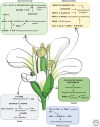Auxin and Flower Development: A Blossoming Field
- PMID: 33355218
- PMCID: PMC7849340
- DOI: 10.1101/cshperspect.a039974
Auxin and Flower Development: A Blossoming Field
Abstract
The establishment of the species-specific floral organ body plan involves many coordinated spatiotemporal processes, which include the perception of positional information that specifies floral meristem and floral organ founder cells, coordinated organ outgrowth coupled with the generation and maintenance of inter-organ and inter-whorl boundaries, and the termination of meristem activity. Auxin is integrated within the gene regulatory networks that control these processes and plays instructive roles at the level of tissue-specific biosynthesis and polar transport to generate local maxima, perception, and signaling. Key features of auxin function in several floral contexts include cell nonautonomy, interaction with cytokinin gradients, and the central role of MONOPTEROS and ETTIN to regulate canonical and noncanonical auxin response pathways, respectively. Arabidopsis flowers are not representative of the enormous angiosperm floral diversity; therefore, comparative studies are required to understand how auxin underlies these developmental differences. It will be of great interest to compare the conservation of auxin pathways among flowering plants and to discuss the evolutionary role of auxin in floral development.
Copyright © 2021 Cold Spring Harbor Laboratory Press; all rights reserved.
Figures


References
-
- Alvarez J, Smyth DR. 1998. Genetic pathways controlling carpel development in Arabidopsis thaliana. J Plant Res 111: 295–298. 10.1007/BF02512187 - DOI
